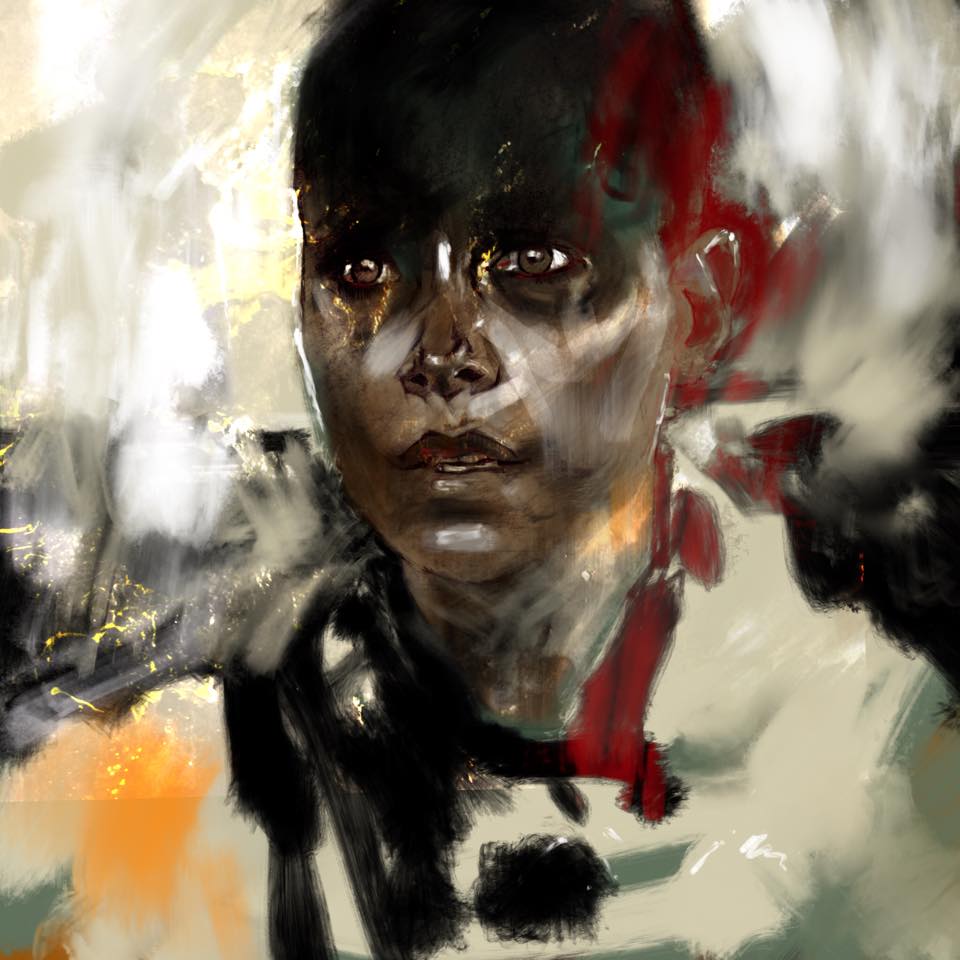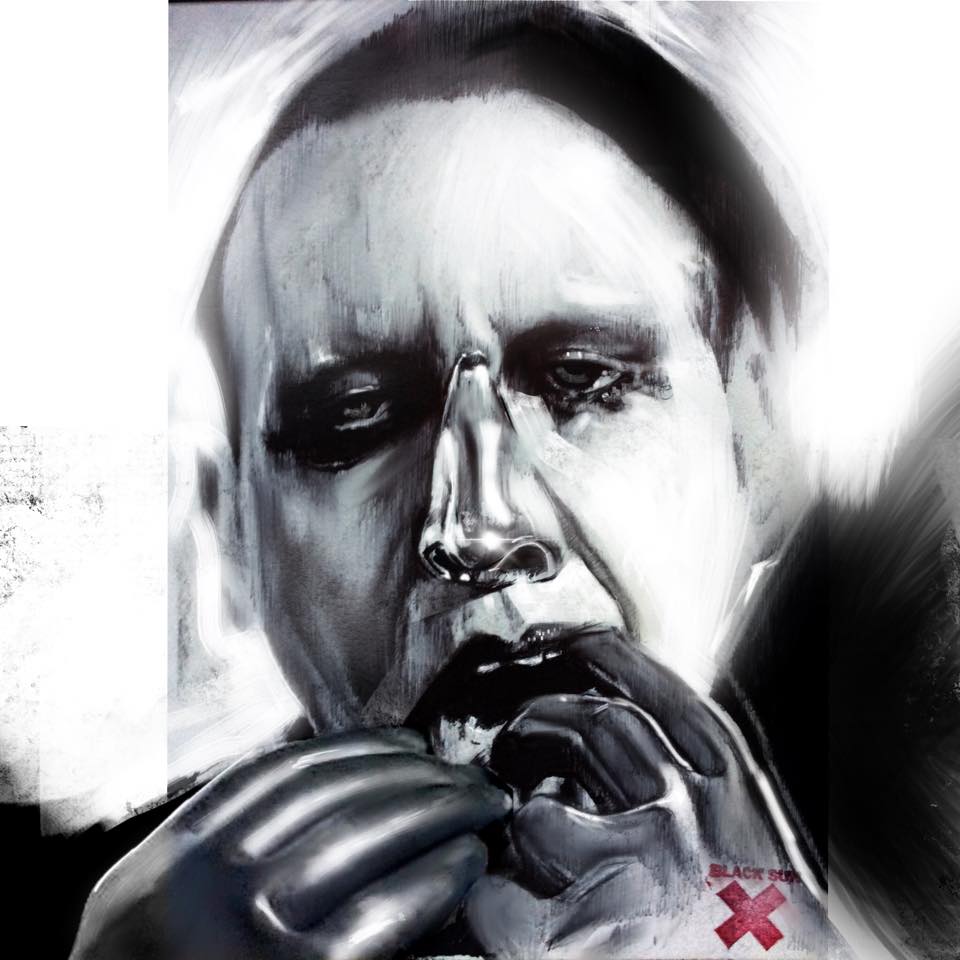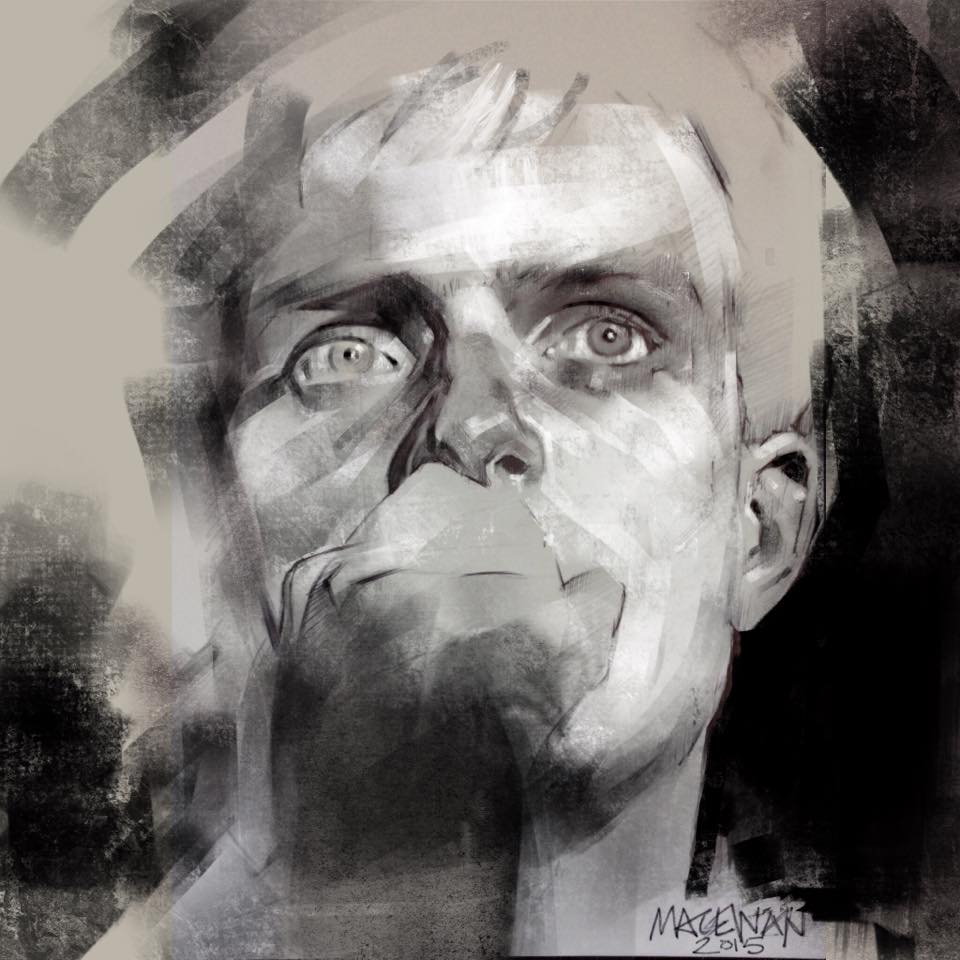[dropcap style=”font-size:100px; color:#992211;”]A[/dropcap]s an art-music overachiever with Black Sun, lecturer and intense performance artist, Russell MacEwan has developed a powerful body of work that pushes art away from the safe areas of the psyche.
Aligned with transgressive figures such as Franko B and Ron Athey, MacEwan’s work challenges the ideas of the body politic as harmonious, whole or heterogeneous. Common to all their work, sexualised themes of mechanisation, violence and primalism are channelled through physical contexts to confront the viewer’s past ideas of the body as mechanism, toward themes of the self as a programmatic function of that mechanism.
Rather than repeating the success of performance art piece Macbeth, where the Scottish play was reimagined as a bloody ritual, MacEwan has devoted himself to reinventing portraiture, or at least faces.
“I don’t draw portraits. I draw a collection of abstract shapes from a process of large general blocks to increasing detail as time goes on. The world falls away for a few hours and I wonder where the time has gone. I dream about shadow and reflected light.”
Containing many of the same themes as his performance art, these works are a personal investigation of identities where the faces of public figures take on a monumental frame, where verisimilitude is adapted to give the sense of movement and change within these archetypal characters.
One of MacEwan’s most visible commissions to date has been to create the cover art for Author & Punisher’s Melk en Honing. Itself a dark portrait of how Tristan Shone sees society’s collapse the artwork matches the mood. Speaking to Trebuchet, MacEwan took us through how a commission became a collaborative journey without end.
“Tristan’s initial brief was for Author & Punisher merchandise. I was out for dinner at the time I got his message, but I said yes and thought about what imagery I could attach to my impression of his music. I started out on a three-part development overall, which seems to be my method – if any. The first is just a warm-up and it takes me a little time to truly get to the marrow of the brief. With ongoing communication between us the brief developed into painting for the cover art and more merchandise
There was a lot of discussion and collaboration. Sometimes I’d draw and paint live as we talked and I’d send ideas over. We’d talk feel and mood, and in many instances I’d work quickly in order to capture some sense of immediacy or spontaneity. All the time with the unmastered Melk En Honing sample tracks playing in the background.
I looked at previous visual interpretations of Tristan’s work which suited where he was, musically, at that time. Recording the new album with Phil Anselmo and his Housecore crew gave Author & Punisher necessary dirt and I felt I was perfect for the task.
One of Tristan’s suggestions was for non-metal imagery. So I immediately thought ‘no Boris Vallego’. Storing ideas is a constant aspect of my ongoing visual research. It’s useful to have it all to hand. Therefore I keep lots on my phone, some prints and books in my studio.
I have two main threads to my approach: very closely observed drawing and much looser painting of field colour with automatic approaches. Being right-handed I use left-handed stuff, and chance to lock in the magic, as Francis Bacon would say. I then combine the two depending on how good it looks. It’s all gut feeling in decision making and looking at it fresh.
Due to Tristan’s openness of mind he is the sort of person who can handle developmental studies as a journey toward unlocking the visual cipher. Others require it imagined wholesale.
I allowed the spirit of the lyrics to seep into my consciousness in an intense listening period, like a Mentat (the human computers from Frank Herbert’s Dune saga). There were strict deadlines on this project which meant many creative periods through the night. It was a fun and exciting period. Tristan’s vocal treatment is also of interest both in the sound and his masks which distort and jitter his voice beyond recognition.
I for one, welcome my new machine overlord.
I create an enormous amount daily and Tristan picked up on one or two emergent moods that he wanted explored further. There were some chance studies I was making in sketchbooks, as well as larger works which took time for the textures to develop.
Contradictorily, I feel that my academic drawing skill allowed for true freedom in shape and form for what became the front cover. There are perhaps primitive echoes of Tristan’s masks or Melk and Honing’s “removed features”
Looking through MacEwan’s work you can’t fail to see the influence of Leigh Bowery. The faces or masks on Melk en Honing have the same fetish quality.
“I love Leigh’s work and the idea that some of his ghost transfers into the metal world makes me very happy indeed. My musical background is post-punk and industrial and I think many creative people came out of that period and influenced me strongly. Hit me like a tonne of bricks. I want to capture some of that weight and apply it to some of my metal clients and collaborators, as it brings some truth in my approach to art.
Naming the two faceless creatures ‘Melk’ and ‘Honig’ (which appear in the gatefold and current tour poster) came about organically, close to the end of the project when I realised one morning that that was who they were. I liked the concept of gentle provision in an easy life juxtaposed with my voidface beestes. The act of painting Honig was very physical indeed, on a one metre square canvas in enamel spray.”
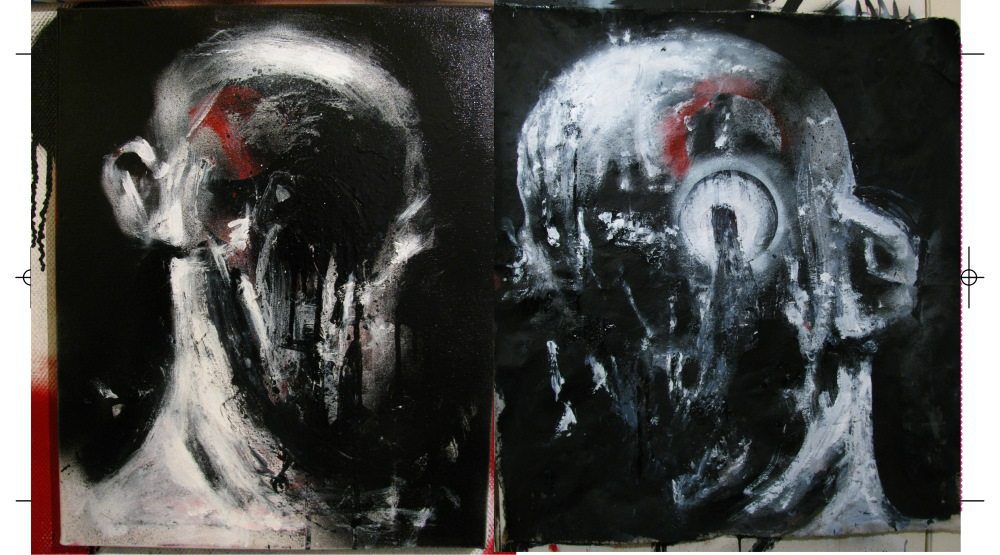
With the commission now completed and the art in the public, one wonders how he sees the finished piece, and the commercial world in general.
“I think it adds to the mystery. I think if I ever reached completion that would be the end of the journey.
I’ve always drawn and designed, especially for Black Sun, and developing my visual side much more seemed logical. You always think about moving forwards and never backwards, hopefully. Given my 37 years playing gigs I think I have the necessary experience to realise visual imagery in music and take it much further than the musician can imagine at first.
I feel I have more of a vision than a fixed style as such. I would say that I have developed my own problem-solving approach to each subject, but I still get excited about how the use of other materials such as acrylic and enamel, charcoal and pencil and ballpoint pen all change the appearance of the end result. I look for a closely observed intensity which describes whatever aspect of the image is required. What that might be exactly I’m not sure.
I think the landscape of the figurative is contained in the abstract and vice-versa. Intense, heavy music such as Author and Punisher suggests the ‘other’ to me; some supernatural attribute or ghost in the machine.
I was thinking about the themes in Arthur C. Clark’s 2001: A Space Odyssey, of our fears of artificial intelligence taking over the human mind being even more relevant today and yet the emotions generated by machine music seem even more powerful than traditional analogue approaches.”
Thinking about MacEwan’s work it’s relatively easy to see the themes at play within the pieces. However, the question of what this creative output means for the artist is harder to discern. You get the impression that creation is more than simple catharsis here, rather something more elemental and ritualised. Where does the energy come from? Does he produce in a frenzy and if the process is the key then can a successful art work ever be achieved?
“No. I’d stop altogether if that was how I felt.
If anything I need a calm and relaxed environment in order to focus properly, at least for a couple of hours at the inception. A couple of beers are cool a little later on but beyond that it all turns to shit. Coming up with strong concepts is like exercising a muscle in that, the more I do it, the luckier I get.
The person who suggested making art for relaxation and pleasure knew the meaning of neither. In some respects it’s an introspective journey at first, with the purpose of creating as much impact as possible. There tends to be a necessary rollercoaster of lows and highs throughout the process. As writer Cormac McCarthy said: “Anything that doesn’t take years of your life and drive you to suicide hardly seems worth doing.”
Links:
https://www.facebook.com/forcemajeureart
https://twitter.com/queen_rousselle
https://instagram.com/black_sun_art/
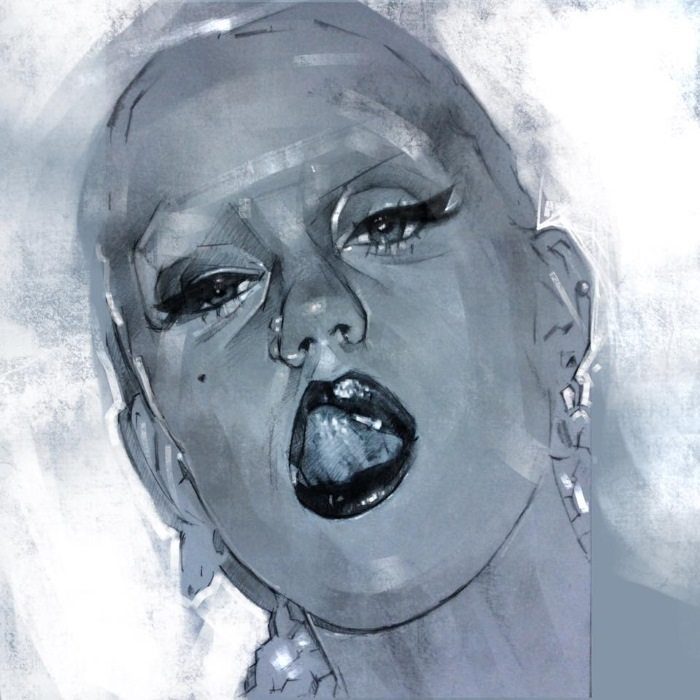

Editor, founder, fan.


